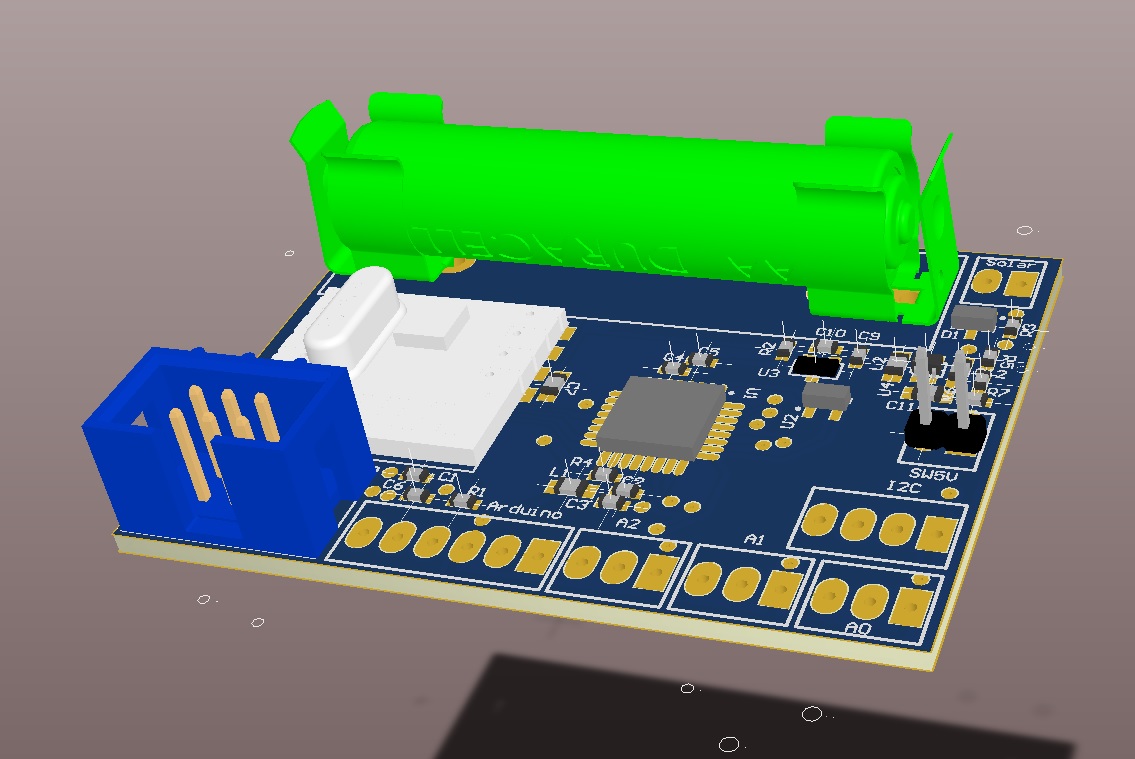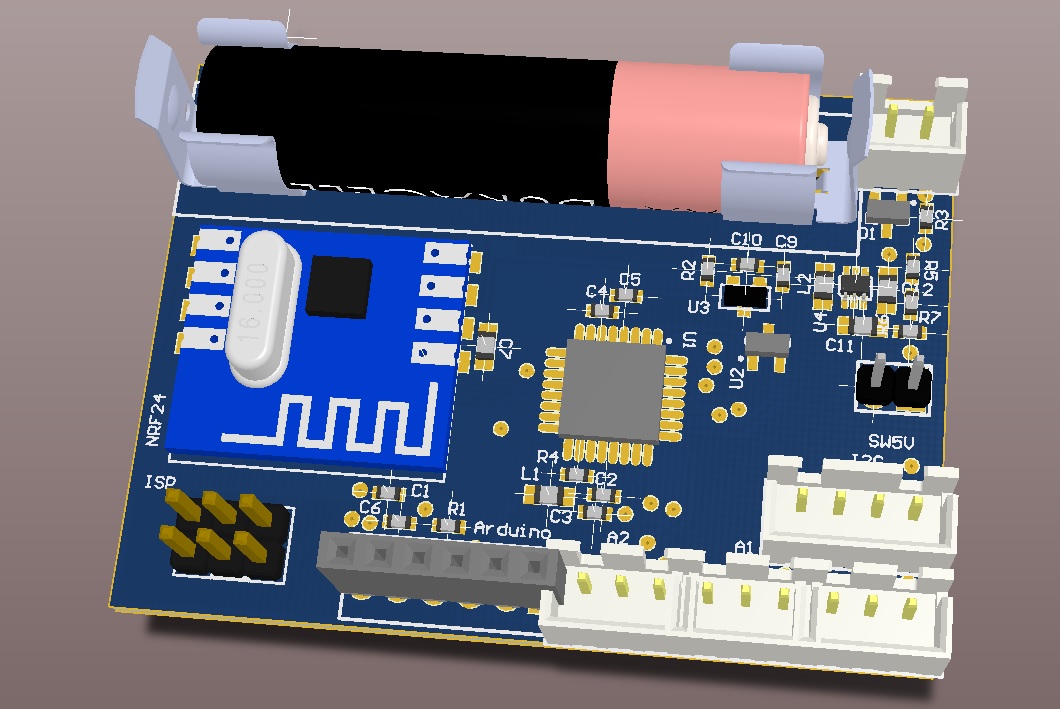Sensor Node V2.0
-
Can't wait to grab a lot of these when they're available:
http://www.seeedstudio.com/wiki/DevDuino_Sensor_Node_V2.0_(ATmega_328)
-
Can't wait to grab a lot of these when they're available:
http://www.seeedstudio.com/wiki/DevDuino_Sensor_Node_V2.0_(ATmega_328)
-
We are going to have a set of Mysensors PCB for different purposes. The first one will be powered from a single AAA alkaline battery and will also have MCP9700 on board
Regardless DevDuino it will have radio on board and will have some more benefitsIt is a good time now before the production to change something. There is no problem to install a precise and low power I2C temperature sensor on board.
But are you ready to pay $1-1.5 more for the board to get ± 0.5 ° C precision instead of ± 2 ° C?
-
We are going to have a set of Mysensors PCB for different purposes. The first one will be powered from a single AAA alkaline battery and will also have MCP9700 on board
Regardless DevDuino it will have radio on board and will have some more benefitsIt is a good time now before the production to change something. There is no problem to install a precise and low power I2C temperature sensor on board.
But are you ready to pay $1-1.5 more for the board to get ± 0.5 ° C precision instead of ± 2 ° C?
-
I'd prefer the hi-res sensor
-
OK, thanks for the feedback
are you talking about default etc. embedded sensor?
you will also have custom connectors to connect any kind of sensorwhat else in your view should be the default option for MySensors.Battery?
@axillent I think that default sensor should be with good precision. In my case i would buy aprox 15 devices like this, and use this over a long period of time(at least few years) so ~20 usd difference in price isn't big. Maybe is worth to think about installing temp and humidity sensor(maybe antother model of device). How do you think - how long it could work on single battery when i need to read temp with 1 or 10 minutes period?
-
software side is of the sensor is as important for the long run as a hardware side
In my assumption if all will be done correctly the average current sourced from the battery will be about 200mkA
this is in assumption of using one sensor for measurement each 1 minute and sending radio for each measurement
for 1A * H battery (should be common for alkaline AAA) it is about 5000 hours or 208 days.
discounting this we should have stable 6 months run timebut only real practice will give us real figures. We plan to have a test run as soon as prototypes will be ready.
also this board is have an optional solar power as a second power
with solar power attached battery life can be increased by 30-50% -
software side is of the sensor is as important for the long run as a hardware side
In my assumption if all will be done correctly the average current sourced from the battery will be about 200mkA
this is in assumption of using one sensor for measurement each 1 minute and sending radio for each measurement
for 1A * H battery (should be common for alkaline AAA) it is about 5000 hours or 208 days.
discounting this we should have stable 6 months run timebut only real practice will give us real figures. We plan to have a test run as soon as prototypes will be ready.
also this board is have an optional solar power as a second power
with solar power attached battery life can be increased by 30-50%@axillent I've noticed solar power pins:) This would be great for outdoor sensors. I think that when suitable solar panel will be used our sensor could work almost without changing battery. Ofcourse until battery really need to be replaced because of phisical damage.
-
Nice PCB design...
Suggested boards:
- 4 PWM logic FETs (dimming RGB W LED strips, 12V lights) Some FETs are easily capable of doing 8 amps and have almost no excess heat.
- 230V AC triac dimmer module (200w that fits in a EU wall box) EU net frequency.
- 0-10V input module (that fits behind a 0-10V dimmer in a wall box. Round max 60mm, thick approx. 15mm) power from 230VAC line.
- 0-10V output module.
- 1..4 channel opto input 3-250v module.
- 1..2 channel solid state relay module.
Can add nice usable parts, example schema's later... main goal good/better cheap(er) open source products!
-
Being able to buy something like this that is "all in one" will be great for us newbies! A more accurate temperature sensor would be ideal and worth the extra dollar!
-
Being able to buy something like this that is "all in one" will be great for us newbies! A more accurate temperature sensor would be ideal and worth the extra dollar!
@Tommy-Sharp "all in one" is one of our goal while working on the project boards
Thanks all for ideas. We plan to have several project specific boards.
First one will be the battery operated board designed for wireless sensors.
Bellow is updated picture, should look better now.
Sensor will be the digital one with precision 0.5C or better and very low power consumptionShould we seriously support 5V from battery? For many applications 3.3V are sufficient and it will consume much less power from the battery.
Relays, dimmers, SSRs will be managed by another board.

-
We are going to have a set of Mysensors PCB for different purposes. The first one will be powered from a single AAA alkaline battery and will also have MCP9700 on board
Regardless DevDuino it will have radio on board and will have some more benefitsIt is a good time now before the production to change something. There is no problem to install a precise and low power I2C temperature sensor on board.
But are you ready to pay $1-1.5 more for the board to get ± 0.5 ° C precision instead of ± 2 ° C?
@axillent How is this project coming along? Looking forward to a standardized PCB version.
-
@axillent How is this project coming along? Looking forward to a standardized PCB version.
@clippermiami we are currently in discussion with possible partners, we discussing production of the PCB and assembled PCB
in parallel I'm doing a prototyping of the battery operated board
Battery operated board will came first, later we plan to release a set of stackable boards ready be used for switching, dimming and integration behind a wall switch -
@clippermiami we are currently in discussion with possible partners, we discussing production of the PCB and assembled PCB
in parallel I'm doing a prototyping of the battery operated board
Battery operated board will came first, later we plan to release a set of stackable boards ready be used for switching, dimming and integration behind a wall switch@axillent LOOKING forward to it, a nice PCB makes a good clean project.
-
@clippermiami we are currently in discussion with possible partners, we discussing production of the PCB and assembled PCB
in parallel I'm doing a prototyping of the battery operated board
Battery operated board will came first, later we plan to release a set of stackable boards ready be used for switching, dimming and integration behind a wall switch@axillent said:
@clippermiami we are currently in discussion with possible partners, we discussing production of the PCB and assembled PCB
in parallel I'm doing a prototyping of the battery operated board
Battery operated board will came first, later we plan to release a set of stackable boards ready be used for switching, dimming and integration behind a wall switchNorth American wall switch?:ballot_box_with_check:
-
@axillent said:
@clippermiami we are currently in discussion with possible partners, we discussing production of the PCB and assembled PCB
in parallel I'm doing a prototyping of the battery operated board
Battery operated board will came first, later we plan to release a set of stackable boards ready be used for switching, dimming and integration behind a wall switchNorth American wall switch?:ballot_box_with_check:
@BulldogLowell from electrical side it is a clear plan to be universal between 110/220V 60/50Hz etc. to support both US and EU standard
from the form factor point of view I have a view to EU standard but not US.. Hopefully we can be universal too but I will need your input on this.
Even I'm not sure what is "North American" stands for :) is it common for US only or for Canada too?While for battery board the design is almost 95% clear the wall board is still under discussion.
Most likely it will be stackable form factor with universal MCU -board and many different power&switch&dimm sub-boards
All feel free to provide your inputs, to share ideas or wishes. -
@BulldogLowell from electrical side it is a clear plan to be universal between 110/220V 60/50Hz etc. to support both US and EU standard
from the form factor point of view I have a view to EU standard but not US.. Hopefully we can be universal too but I will need your input on this.
Even I'm not sure what is "North American" stands for :) is it common for US only or for Canada too?While for battery board the design is almost 95% clear the wall board is still under discussion.
Most likely it will be stackable form factor with universal MCU -board and many different power&switch&dimm sub-boards
All feel free to provide your inputs, to share ideas or wishes.@axillent North American standard is common to both US and Canada.
